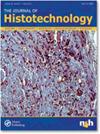What 2022 is bringing to the Journal of Histotechnology and its first issue of the year
IF 0.6
4区 生物学
Q4 CELL BIOLOGY
引用次数: 0
Abstract
The beginning of 2022 is much like 2021 with hopes that the COVID pandemic fades away forever. Hopefully, our colleagues in clinical and research histotechnology can return to a normal status for staffing and product shortages to provide the needed care to patients. The Journal of Histotechnology (JOH) 45 Anniversary Special Issue on Ocular Histology will be a way of celebrating the many years our journal has been published. There is a call for the submissions to this special issue with two guest editors, Drs. Yongfu Wang and Sanming Li. Please look for this call for manuscripts on the JOH webpage, the National Society for Histotechnology website, and social media as there is a submission deadline. This first 2022 issue has two papers on decalcification for two different animal models. Marinopoulos and colleagues compared and optimized two decalcification techniques along with the H&E stain and an immunohistochemical assay on the rat maxilla and mandibles for their toxicology studies. The photo figures are outstanding, particularly the teeth – one of the most difficult tissues to work with in the histology laboratory. The other comes from Cecily Broomfield and group with a detailed study of much larger, dense ovine spine and shoulder bone samples to compare six decalcification methods to achieve increased cellular detail. As they pointed out, decalcification procedures in the literature for murine and lapin bone are “welldocumented” but not for ovine bone. The study of fallopian tube anatomy and mechanical properties to know pressure limits via endoscopic examination by Rice et al. used to determine the origin of early-stage ovarian cancer, inflammatory disease, and infertility in women was very interesting. Once again, an animal model (pig) was used along with human tissues to test their methods. Immunohistochemical studies on factors having a role in tumor carcinogenesis, differentiation, and prognosis continue and even used as a therapeutic target are ongoing as seen in the paper on urinary bladder cancer by Reman Sameh group. The case study by Vincek and Rudnik pointed out that the Melan-A marker cross reacts with Molluscum contagiosum cutaneous lesions, particularly in challenging cases with highly inflamed or minimal samples when the H&E may not establish a diagnosis. Case histories are very popular and I hope more are submitted to the journal in the future. How many histotechnicians are aware the eosinophils can be stained green instead of the commonly seen red color from eosin? Take Tony Henwood’s Test Your Knowledge quiz and learn more about other methods with different dyes used to detect eosinophils and earn CEU credits. My compliments to the authors and their colleagues for submitting interesting, informative articles, especially the finely detailed methods and materials for histotechniques used in their studies. We encourage others who submit a manuscript to this journal to do the same as we remain very technology oriented to use and/or repeat the methods. Happy belated New Year to all.2022年将给《组织技术杂志》和今年的第一期带来什么
2022年初很像2021年,希望新冠疫情永远消失。希望我们在临床和研究组织技术方面的同事能够在人员配备和产品短缺的情况下恢复正常状态,为患者提供所需的护理。《组织技术杂志》(JOH)眼部组织学45周年特刊将是庆祝我们杂志出版多年的一种方式。本期特刊现邀请两位特约编辑投稿。王永福和李三明。请在JOH网页,国家组织技术学会网站和社交媒体上寻找这一手稿征集,因为有提交截止日期。2022年第一期有两篇关于两种不同动物模型脱钙的论文。Marinopoulos和他的同事比较并优化了两种脱钙技术以及H&E染色和免疫组织化学在大鼠上颌和下颌骨上的毒理学研究。照片上的数字非常出色,尤其是牙齿——在组织学实验室中最难处理的组织之一。另一项研究来自Cecily Broomfield,她对更大、更密集的羊脊柱和肩骨样本进行了详细研究,比较了六种脱钙方法,以获得更多的细胞细节。正如他们所指出的那样,文献中对小鼠和lapin骨的脱钙程序是“有充分记录的”,但对羊骨则没有。Rice等人通过内窥镜检查输卵管解剖和力学特性来了解压力极限的研究,用于确定女性早期卵巢癌、炎性疾病和不孕症的起源,这是非常有趣的。他们再次使用动物模型(猪)和人体组织来测试他们的方法。如Reman Sameh组关于膀胱癌的论文所示,对肿瘤发生、分化和预后有作用的因子的免疫组化研究仍在继续,甚至被用作治疗靶点。Vincek和Rudnik的案例研究指出,Melan-A标记交叉反应与传染性软疣皮肤病变有关,特别是在H&E可能无法诊断的高度炎症或极小样本的挑战性病例中。病历非常受欢迎,我希望将来有更多的病例提交给杂志。有多少组织技术人员知道嗜酸性粒细胞可以被染成绿色,而不是常见的伊红红色?参加Tony Henwood的Test Your Knowledge测验,了解更多使用不同染料检测嗜酸性粒细胞的其他方法,并获得CEU学分。我对作者和他们的同事们提交的有趣、翔实的文章表示赞赏,尤其是他们研究中使用的组织技术的详细方法和材料。我们鼓励其他向本杂志投稿的人也这样做,因为我们仍然以技术为导向,使用和/或重复这些方法。祝大家迟来的新年快乐。
本文章由计算机程序翻译,如有差异,请以英文原文为准。
求助全文
约1分钟内获得全文
求助全文
来源期刊

Journal of Histotechnology
生物-细胞生物学
CiteScore
2.60
自引率
9.10%
发文量
30
审稿时长
>12 weeks
期刊介绍:
The official journal of the National Society for Histotechnology, Journal of Histotechnology, aims to advance the understanding of complex biological systems and improve patient care by applying histotechniques to diagnose, prevent and treat diseases.
Journal of Histotechnology is concerned with educating practitioners and researchers from diverse disciplines about the methods used to prepare tissues and cell types, from all species, for microscopic examination. This is especially relevant to Histotechnicians.
Journal of Histotechnology welcomes research addressing new, improved, or traditional techniques for tissue and cell preparation. This includes review articles, original articles, technical notes, case studies, advances in technology, and letters to editors.
Topics may include, but are not limited to, discussion of clinical, veterinary, and research histopathology.
 求助内容:
求助内容: 应助结果提醒方式:
应助结果提醒方式:


